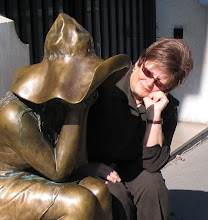In honor of my Dad’s birthday (85 yrs.) I took him to an exhibit of early Portland houses, '”At Home in Portland, 1909-1914.” My dad has a phenomenal memory and has always been interested in history, so I figured this was a winner.
The exhibit took place at the Pittock Mansion, a residence and grounds now owned by the city of Portland Parks Department. As sometimes happens, the unplanned became more interesting than the event itself. A tour guide was just starting her walk through the mansion and we ended up tailing along, although our intention was the exhibit in the basement. We followed the group lagging further and further behind because Dad likes to read all the signs and captions (and hearing at the back of a group is difficult).
Henry Pittock was a 19 year old Englishman who came to Oregon with his brother in 1853 via the Oregon Trail. He started out as a typesetter for the bi-weekly newspaper and worked his way up through the staff until he was editor, then partner, then full owner of the paper, which he quickly turned into a daily paper.
He married at age 26 the 15 year old Georgiana who had just graduated from Portland Academy, a Methodist institution. They had 9 (or 8) children, 7 (or 6) of whom survived to adulthood. Together they helped Portland transition from a pioneer town to the enterprising city it is today.
Henry had interests in real estate, banking, railroads, steamboats, sheep ranching, silver mining, and the pulp and paper industry, besides running the daily paper. Georgina founded several organizations for the support of women, needy children, and single working women.
Their family was nearly raised when they commissioned a young architect (the son of one of Pittock’s employees at the paper) to design this large estate for them. They were in the heyday of public service and business at this point in their lives; extracurricular activities for Henry included horseback riding, bicycling, and mountain climbing (he was in the first group to scale Mt. Hood to the top). Georgiana’s extensive gardens and shows led to the now annual Portland Rose Festival.
In 1909 the plans were drawn and the house was finished in 1914. Henry was 80 and Georgiana was 68 when they moved into their new home overlooking the city they had helped to build up. Two married children and a few grandchildren lived in the house as well. One grandson was born in the house and lived there until the early 1960’s when it was put up for sale.
After a severe windstorm damaged the property and it faced demolition, concerned citizens formed a rescue effort raising enough to enable the city of Portland to buy this beautiful home and 44 acre hilltop property for $225,000.
Above: the “proper” front door
Below: The porte-cochere where most people entered
Built in the French-Revival-Chateauesque School
Georgiana’s sewing room, above. The grandchildren’s bedroom, below, included Eastlake bed and puppet theater.
Dining room, sorry, no flash allowed, so fuzzy:
Music room, rosewood piano from 1885, and harp:
The view from the marble baking counter:
Turkish smoking room:


More of the kitchen cupboard pantry:
This home was years ahead of its time in electrical, plumbing, telephone and intercom services. My pictures don’t do justice to every thought given. The Master dressing room closets are to die for!
By the time we got to the basement where our real intention was, we were so intrigued by the Pittocks’ activities we could hardly take in what other people were building in 1914. But Dad did recognize and name many of the homes in the advertising flyers and newspaper ads of the day. They were owned by the ‘Movers and Shakers’ on a slightly lesser scale. Sadly, many of these homes are gone now, giving way to another generation of ideas and needs.
One of the values Henry Pittock held strongly was in using local labor and materials and using local people as craftsmen. He used and encouraged young workers. (His architect was fresh out of school.) He wanted to build up the local community and he put his money where his mouth was.
As we drove around town afterwards, Dad pointed out routes “that used to be the way to the beach until they built the new… in 1935” and where the streetcar used to run up to Council Crest which was a popular Sunday destination, and so on. I told him I needed to have a tape recorder while I am driving around with him, because no one knows this stuff anymore. Besides his age, he remembers this history because even as a young person he was interested in roads and buildings and so he paid attention to it. I wish I had in my head what he knows about the older days in Portland.














5 comments:
What a wonderful day for your Dad! And do get what he remembers written down, taped, whatever. Once he is gone, those memories are gone forever. My sister and I wish again and again we had asked our parents more questions about their past!
What a wonderful post. Your Dad is so handsome! Your heart must burst with thanks with the blessing of a Dad this age who still has a clear mind. So much to share. What a house - enjoyed the pics.
Happy Birthday to your Dad. What a beautiful house! I would love to tour a home like that.
Thank you for the blog visit. I always enjoy "meeting" someone new!
That looks like a fabulous place to take your dad...or anyone for that matter!
I had to think of my dad (now 87) and how he remembers so many details from way back when. I think our dads would get along just fine!
Nice essay, Holly. Glad you and Dad were able to have that time together.
Post a Comment